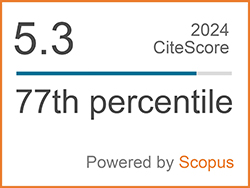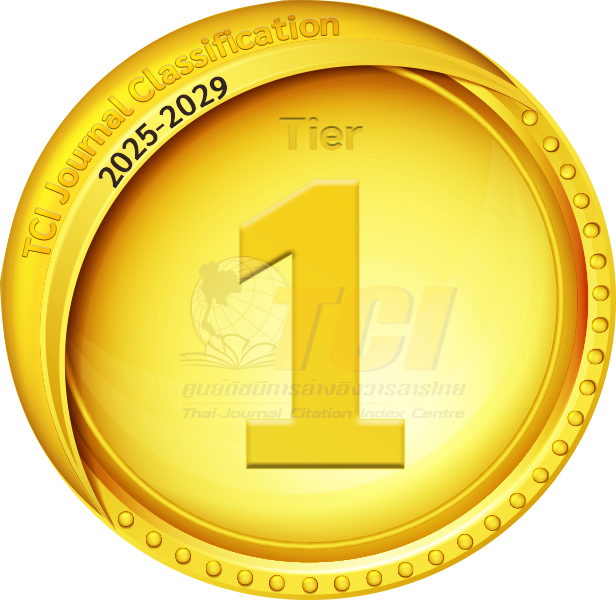Performance of Green Microalgae-Activated Sludge and Diatom-Activated Sludge Co-Cultures in Kitchen Wastewater Treatment: Nutrient Removal Efficiency and Cellular Fatty Acid Profiling
Abstract
Keywords
[1] I. N. Shaikh and M. M. Ahammed, “Quantity and quality characteristics of greywater from an Indian household,” Environmental Monitoring and Assessment, vol. 194, no. 3, Mar. 2022, doi: 10.1007/s10661-022-09820-0.
[2] P. R. Rout et al., “Nutrient removal from domestic wastewater: A comprehensive review on conventional and advanced technologies,” Journal of Environmental Management, vol. 296, p. 113246, Oct. 2021, doi: 10.1016/j.jenvman.2021.113246.
[3] S. J. Mane, P. Kumbhare, and A. Pandav, “Experimental study of treatment of kitchen waste water using rice husk ash,” Materials Today: Proceedings, Feb. 2024, doi: 10.1016/j.matpr.2024.01.056.
[4] P. Moñino et al., “A new strategy to maximize organic matter valorization in municipalities: Combination of urban wastewater with kitchen food waste and its treatment with AnMBR technology,” Waste Management, vol. 62, pp. 274–289, Apr. 2017, doi: 10.1016/j.wasman. 2017.02.006.
[5] V. S. Neeraj, A. Arunangiri, and K. Muthukumar, “Treatment of Kitchen Wastewater in a Batch Electrochemical Reactor,” Journal of The Institution of Engineers (India): Series E, vol. 104, no. 1, pp. 185–194, Jun. 2023, doi: 10.1007/s40034-022-00262-4.
[6] J. Zhang et al., “Enhanced purification and disinfection of restaurant wastewater by electro-coagulation coupled with an electro-oxidation process: From lab scale to field scale,” ACS ES and T Engineering, vol. 3, no. 7, pp. 932–943, Jul. 2023, doi: 10.1021/acsestengg.2c00381.
[7] T. S. Le et al., “Two-stage anaerobic membrane bioreactor for co-treatment of food waste and kitchen wastewater for biogas production and nutrients recovery,” Chemosphere, vol. 309, p. 136537, Dec. 2022, doi: 10.1016/ j.chemosphere.2022.136537.
[8] K. Katam, Y. Tiwari, T. Shimizu, S. Soda, and D. Bhattacharyya, “Start-up of a trickling photobioreactor for the treatment of domestic wastewater,” Water Environment Research, vol. 93, no. 9, pp. 1690–1699, Sep. 2021, doi: 10.1002/wer.1554.
[9] S. F. Mohsenpour, S. Hennige, N. Willoughby, A. Adeloye, and T. Gutierrez, “Integrating micro-algae into wastewater treatment: A review,” Science of The Total Environment, vol. 752, p. 142168, Jan. 2021, doi: 10.1016/ J.SCITOTENV.2020.142168.
[10] V. Matamoros, E. Uggetti, J. García, and J. M. Bayona, “Assessment of the mechanisms involved in the removal of emerging contaminants by microalgae from wastewater: A laboratory scale study,” Journal of Hazardous Materials, vol. 301, pp. 197–205, Jan. 2016, doi: 10.1016/j.jhazmat.2015.08.050.
[11] S. Pandey, I. Narayanan, R. Selvaraj, T. Varadavenkatesan, and R. Vinayagam, “Biodiesel production from microalgae: A comprehensive review on influential factors, transesterification processes, and challenges,” Fuel, vol. 367. p. 131547, Jul. 01, 2024. doi: 10.1016/j.fuel.2024.131547.
[12] A. Saravanan et al., “A review on algal-bacterial symbiotic system for effective treatment of wastewater,” Chemosphere, vol. 271, p. 129540, May 2021, doi: 10.1016/j.chemosphere.2021. 129540.
[13] C. S. Lee, S.-A. Lee, S.-R. Ko, H.-M. Oh, and C.-Y. Ahn, “Effects of photoperiod on nutrient removal, biomass production, and algal-bacterial population dynamics in lab-scale photobioreactors treating municipal wastewater,” Water Research, vol. 68, pp. 680–691, Jan. 2015, doi: 10.1016/ J.WATRES.2014.10.029.
[14] M. A. M. Condori, M. M. Condori, M. E. V. Gutierrez, F. J. Choix, and F. García-Camacho, “Bioremediation potential of the Chlorella and Scenedesmus microalgae in explosives production effluents,” Science of the Total Environment, vol. 920, p. 171004, Apr. 2024, doi: 10.1016/ j.scitotenv.2024.171004.
[15] J. J. Ortiz-Betancur et al., “Application of Chlorella sp. and Scenedesmus sp. in the bioconversion of urban leachates into industrially relevant metabolites,” Applied Sciences (Switzerland), vol. 12, no. 5, p. 2462, Feb. 2022, doi: 10.3390/ app12052462.
[16] T. K. Marella, N. R. Parine, and A. Tiwari, “Potential of diatom consortium developed by nutrient enrichment for biodiesel production and simultaneous nutrient removal from waste water,” Saudi Journal of Biological Sciences, vol. 25, no. 4, pp. 704–709, May 2018, doi: 10.1016/j.sjbs.2017.05.011.
[17] M. K. Kumara, R. K. Oruganti, R. Tejavath, M. Sriariyanun, A. Tawai, and D. Bhattacharyya, “The potential application of diatom-aided constructed floating wetlands for domestic wastewater treatment,” Applied Science and Engineering Progress, vol. 18, no. 2, 2025, Art. 7662, doi: 10.14416/j.asep.2024.12.004.
[18] I. Rawat, R. R. Kumar, T. Mutanda, and F. Bux, “Dual role of microalgae: Phycoremediation of domestic wastewater and biomass production for sustainable biofuels production,” Applied Energy, vol. 88, no. 10, pp. 3411–3424, Oct. 2011, doi: 10.1016/J.APENERGY.2010.11.025.
[19] C. Koedooder et al., “Diatom-bacteria interactions modulate the composition and productivity of benthic diatom biofilms,” Frontiers in Microbiology, vol. 10, p. 454984, Jun. 2019, doi: 10.3389/fmicb.2019.01255.
[20] L. K. Akula, R. K. Oruganti, D. Bhattacharyya, and K. K. Kurilla, “Treatment of marigold flower processing wastewater using a sequential biological-electrochemical process,” Applied Science and Engineering Progress, vol. 14, no. 3, pp. 525–542, 2021, doi: 10.14416/j.asep. 2021.04.001.
[21] APHA/AWWA/WEF, Standard Methods for the Examination of Water and Wastewater, 22nd ed. Washington, DC, USA: American Public Health Association, 2012.
[22] S. V. Wychen and L. M. L. Laurens, “Determination of total lipids as fatty acid methyl esters (FAME) by in situ transesterification: Laboratory analytical procedure (LAP),” National Renewable Energy Laboratory (NREL), Golden, CO, USA, Tech. Rep. NREL/TP-5100-60958, May 2013.
[23] C. Gurd, B. Jefferson, and R. Villa, “Characterisation of food service establishment wastewater and its implication for treatment,” Journal of Environmental Management, vol. 252, p. 109657, Dec. 2019, doi: 10.1016/ j.jenvman.2019.109657.
[24] A. Babu, K. Katam, M. P. Gundupalli, and D. Bhattacharyya, “Nutrient removal from wastewater using microalgae: A kinetic evaluation and lipid analysis,” Water Environment Research, vol. 90, no. 6, pp. 520–529, Jun. 2018, doi: 10.2175/106143017X15054 988926299.
[25] A. Gupta and J. R. Nath, Kitchen Greywater Treatment in a Constructed Wetland Microcosm Using Aquatic Macrophytes. Singapore: Springer, 2018, pp. 141–149, doi: 10.1007/978-981-10-5795-3_13.
[26] X. Zheng et al., “Increasing municipal wastewater BNR by using the preferred carbon source derived from kitchen wastewater to enhance phosphorus uptake and short-cut nitrification-denitrification,” Chemical Engineering Journal, vol. 344, pp. 556–564, Jul. 2018, doi: 10.1016/ j.cej.2018.03.124.
[27] P. K. Kumar, S. V. Krishna, S. S. Naidu, K. Verma, D. Bhagawan, and V. Himabindu, “Biomass production from microalgae Chlorella grown in sewage, kitchen wastewater using industrial CO2 emissions: Comparative study,” Carbon Resources Conversion, vol. 2, no. 2, pp. 126–133, Aug. 2019, doi: 10.1016/j.crcon.2019. 06.002.
[28] A. Huelgas, M. Nakajima, H. Nagata, and N. Funamizu, “Comparison between treatment of kitchen-sink wastewater and a mixture of kitchen-sink and washing-machine wastewaters,” Environmental technology, vol. 30, no. 1, pp. 111–117, 2009, doi: 10.1080/09593330802445549.
[29] A. Bindhuraj, S. V. Paulose, S. Asharaf, and S. Joseph, “A comparative study on the treatment of kitchen grey water using microalgae consortia and microalgae-synthesized silver nanoparticles,” Environmental Science and Pollution Research, vol. 31, no. 60, pp. 67521–67533, Dec. 2024, doi: 10.1007/S11356-024-33655-6/METRICS.
[30] N. Hendrasarie, M. Nugraha, and K. Fadilah, “Restaurant wastewater treatment with a two-chamber septic tank and a sequencing batch reactor,” E3S Web of Conferences, vol. 328, p. 01011, 2021, doi: 10.1051/e3sconf/202132801011.
[31] K. Katam and D. Bhattacharyya, “Simultaneous treatment of domestic wastewater and bio-lipid synthesis using immobilized and suspended cultures of microalgae and activated sludge,” Journal of Industrial and Engineering Chemistry, vol. 69, pp. 295–303, Jan. 2019, doi: 10.1016/j.jiec.2018.09.031.
[32] P. Kuczynska, M. Jemiola-Rzeminska, and K. Strzalka, “Photosynthetic pigments in diatoms,” Marine Drugs, vol. 13, no. 9. MDPI AG, pp. 5847–5881, Sep. 01, 2015. doi: 10.3390/md1309 5847.
[33] K. Katam and D. Bhattacharyya, “Comparative study on treatment of kitchen wastewater using a mixed microalgal culture and an aerobic bacterial culture: kinetic evaluation and FAME analysis,” Environmental Science and Pollution Research, vol. 25, no. 21, pp. 20732–20742, 2018, doi: 10.1007/s11356-018-2209-6.
[34] A. Y. Radeef, A. A. Najim, H. A. Karaghool, and Z. H. Jabbar, “Sustainable kitchen wastewater treatment with electricity generation using upflow biofilter-microbial fuel cell system,” Biodegradation, vol. 35, no. 6, pp. 893–906, Oct. 2024, doi: 10.1007/s10532-024-10087-0.
[35] G. Baskar, V. T. Deeptha, and A. A. Rahman, “Treatment of wastewater from kitchen in an institution hostel mess using constructed wetland,” International Journal of Recent Trends in Engineering, vol. 1, no. 6, pp. 54–58, 2009.
[36] E. Kazamia et al., “Mutualistic interactions between vitamin B12-dependent algae and heterotrophic bacteria exhibit regulation,” Environmental Microbiology, vol. 14, no. 6, pp. 1466–1476, 2012, doi: 10.1111/j.1462-2920.2012. 02733.x.
[37] J. J. Cole, “Interactions Between Bacteria and Algae in Aquatic Ecosystems,” Annual Review of Ecology and Systematics, vol. 13, no. 1, pp. 291–314, Nov. 1982, doi: 10.1146/annurev.es. 13.110182.001451.
[38] A. W. Decho and T. Gutierrez, “Microbial extracellular polymeric substances (EPSs) in ocean systems,” Frontiers in Microbiology, vol. 8, p. 922, May 2017, doi: 10.3389/ FMICB.2017.00922.
[39] H. Xu, F. Chen, X. Zhang, Z. Zhang, K. Pan, and H. Liu, “Grazer-induced changes on mechanical properties of diatoms frustule: A new proof for a watery arms race,” Limnology and Oceanography Letters, vol. 9, no. 6, pp. 754–763, Dec. 2024, doi: 10.1002/LOL2.10419.
[40] A. Kamp, D. D. Beer, J. L. Nitsch, G. Lavik, and P. Stief, “Diatoms respire nitrate to survive dark and anoxic conditions,” Proceedings of the National Academy of Sciences of the United States of America, vol. 108, no. 14, pp. 5649–5654, Apr. 2011, doi: 10.1073/pnas.1015744108.
[41] C. Wilhelm et al., “The regulation of carbon and nutrient assimilation in diatoms is significantly different from green algae,” Protist, vol. 157, no. 2, pp. 91–124, Jun. 2006, doi: 10.1016/j.protis. 2006.02.003.
[42] M. Sweiss et al., “Qualitative and quantitative evaluation of microalgal biomass using portable attenuated total reflectance-Fourier transform infrared spectroscopy and machine learning analytics,” Journal of Chemical Technology and Biotechnology, vol. 99, no. 1, pp. 92–108, Jan. 2024, doi: 10.1002/jctb.7512.
[43] M. Janssen, R. H. Wijffels, and M. J. Barbosa, “Microalgae based production of single-cell protein,” Current Opinion in Biotechnology, vol. 75, p. 102705, Jun. 2022, doi: 10.1016/ J.COPBIO.2022.102705.
[44] E. E. Ammar et al., “Algae as Bio-fertilizers: Between current situation and future prospective,” Saudi Journal of Biological Sciences, vol. 29, no. 5, pp. 3083–3096, May 2022, doi: 10.1016/J.SJBS.2022.03.020.
[45] P. Parmar, R. Kumar, Y. Neha, and V. Srivatsan, “Microalgae as next generation plant growth additives: Functions, applications, challenges and circular bioeconomy based solutions,” Frontiers in Plant Science, vol. 14, p. 1073546, Mar. 2023, doi: 10.3389/FPLS.2023.1073546/ XML/NLM.
[46] M. Cabrera-Brufau, L. Arin, M. M. Sala, P. Cermeño, and C. Marrasé, “Diatom Dominance Enhances Resistance of Phytoplanktonic POM to Mesopelagic Microbial Decomposition,” Frontiers in Marine Science, vol. 8, p. 683354, Jun. 2021, doi: 10.3389/FMARS.2021.683354/ XML/NLM.
[47] B. Moriceau et al. , “Si–C interactions during degradation of the diatom Skeletonema marinoi,” Deep Sea Research Part II: Topical Studies in Oceanography, vol. 56, no. 18, pp. 1381–1395, Aug. 2009, doi: 10.1016/J.DSR2.2008.11.026.
[48] P. Sarkar, T. K. Bandyopadhyay, K. Gopikrishna, O. Nath Tiwari, B. Bhunia, and M. Muthuraj, “Algal carbohydrates: Sources, biosynthetic pathway, production, and applications,” Bioresource Technology, vol. 413, p. 131489, Dec. 2024, doi: 10.1016/J.BIORTECH.2024.131489.
[49] G. Knothe, “Dependence of biodiesel fuel properties on the structure of fatty acid alkyl esters,” Fuel Processing Technology, vol. 86, no. 10, pp. 1059–1070, Jun. 2005, doi: 10.1016/ J.FUPROC.2004.11.002.
[50] K. Katam, M. P. Gundupalli, and D. Bhattacharyya, “Production of biofuel from kitchen wastewater by using a mixed culture of diatoms: Treatment, kinetic evaluation, and lipid analysis,” in ASCE India Conference 2017, Dec. 2018, pp. 278–287, doi: 10.1061/978078448 2025.029.
[51] G. A. Dunstan, J. K. Volkman, S. M. Barrett, J. M. Leroi, and S. W. Jeffrey, “Essential polyunsaturated fatty acids from 14 species of diatom (Bacillariophyceae),” Phytochemistry, vol. 35, no. 1, pp. 155–161, Dec. 1993, doi: 10.1016/S0031-9422(00)90525-9.
[52] J. B. Parsons and C. O. Rock, “Bacterial lipids: Metabolism and membrane homeostasis,” Progress in Lipid Research, vol. 52, no. 3. pp. 249–276, Jul. 2013. doi: 10.1016/j.plipres.2013. 02.002.
[53] W. N. A. W. Osman, M. H. Rosli, W. N. A. Mazli, and S. Samsuri, “Comparative review of biodiesel production and purification,” Carbon Capture Science and Technology, vol. 13, p. 100264, Dec. 2024, doi: 10.1016/j.ccst.2024. 100264.
[54] M. P. Devi, G. V. Subhash, and S. V. Mohan, “Heterotrophic cultivation of mixed microalgae for lipid accumulation and wastewater treatment during sequential growth and starvation phases: Effect of nutrient supplementation,” Renewable Energy, vol. 43, pp. 276–283, 2012, doi: 10.1016/j.renene.2011.11.021.
[55] A. Saxena and A. Tiwari, “Biodiesel Production and Advancement from Diatom Algae,” in Bioenergy Research: Evaluating Strategies for Commercialization and Sustainability, New Jersey: John Wiley & Sons, Ltd., 2021, pp. 261–277. doi: 10.1002/9781119772125.ch12.
[56] K. Katam and D. Bhattacharyya, “Effect of solids retention time on the performance of alga-activated sludge association in municipal wastewater treatment and biofuel production,” Journal of Applied Phycology, vol. 32, no. 3, pp. 1803–1812, Mar. 2020, doi: 10.1007/s10811-020-02076-6.
[57] D. De Francisci, Y. Su, A. Iital, and I. Angelidaki, “Evaluation of microalgae production coupled with wastewater treatment,” Environmental Technology (United Kingdom), vol. 39, no. 5, pp. 581–592, Mar. 2018, doi: 10.1080/09593330.2017.1308441;SUBPAGE:STRING:ACCESS.
[58] F. Javed, F. Rehman, A. U. Khan, T. Fazal, A. Hafeez, and N. Rashid, “Real textile industrial wastewater treatment and biodiesel production using microalgae,” Biomass and Bioenergy, vol. 165, p. 106559, Oct. 2022, doi: 10.1016/ j.biombioe.2022.106559.
[59] R. Rehman et al., “Algal-biochar and Chlorella vulgaris microalgae: A sustainable approach for textile wastewater treatment and biodiesel production,” Biochar, vol. 6, no. 1, pp. 1–16, Dec. 2024, doi: 10.1007/s42773-024-00358-7.
[60] S. Cho et al., “Microalgae cultivation for bioenergy production using wastewaters from a municipal WWTP as nutritional sources,” Bioresource Technology, vol. 131, pp. 515–520, Mar. 2013, doi: 10.1016/j.biortech.2012.12.176.
[61] I. Ambat, S. Bec, E. Peltomaa, V. Srivastava, A. Ojala, and M. Sillanpää, “A synergic approach for nutrient recovery and biodiesel production by the cultivation of microalga species in the fertilizer plant wastewater,” Scientific Reports, vol. 9, no. 1, p. 19073, Dec. 2019, doi: 10.1038/s41598-019-55748-w.
[62] L. Luo et al., “Simultaneous nutrition removal and high-efficiency biomass and lipid accumulation by microalgae using anaerobic digested effluent from cattle manure combined with municipal wastewater,” Biotechnology for Biofuels, vol. 12, no. 1, p. 218, Sep. 2019, doi: 10.1186/S13068-019-1553-1.
DOI: 10.14416/j.asep.2025.10.005
Refbacks
- There are currently no refbacks.
 Applied Science and Engineering Progress
Applied Science and Engineering Progress







